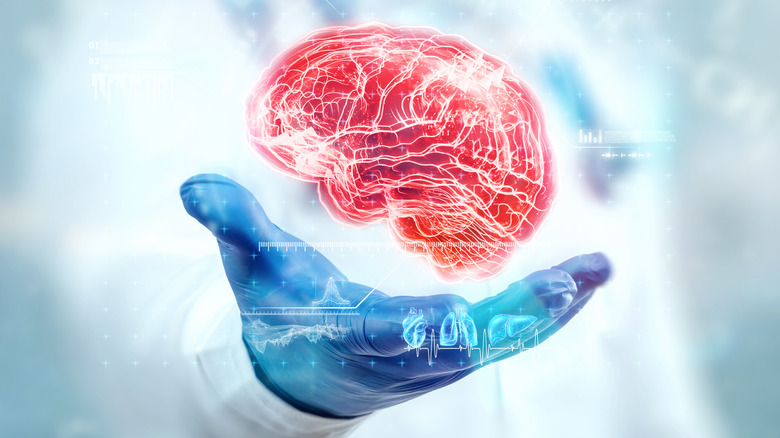Myths You Should Stop Believing About Parkinson's Disease
Parkinson's disease is among the most common neurodegenerative diseases in the United States (via the Parkinson's Foundation). About one million people in the United States (and over 10 million throughout the world) have the disease. An estimated 90,000 people are diagnosed with the disease every year, up 50% from the previous estimate of 60,000 per year. The increase is credited to the rising age of our population. Examples of well-known people who have or had Parkinson's disease include Michael J. Fox, Muhammad Ali, Billy Graham, Johnny Cash, and Pope John Paul II (via the American Association of Neurological Surgeons).
The most common symptoms of Parkinson's disease include tremors in your fingers, hands, or arm, according to the Mayo Clinic. You may experience stiff muscles in any part of your body, trouble with your balance, and a stooped posture. Common movements such as blinking or smiling may be impaired, your stride may become shorter, and you could start shuffling or dragging your feet. Writing by hand tends to become more difficult, and the size of your writing may get smaller.
Parkinson's disease can be a scary diagnosis, partly because of the many myths surrounding the condition. By separating fiction from fact, you can take your first step toward minimizing the fear factor, gaining a better understanding of the disease and its treatment options, and cultivating a more positive attitude toward the condition.
Myth: Only old people get Parkinson's disease
While the average age of people diagnosed with Parkinson's disease is 60, some people develop the disease in their 50s, and a small percentage in their 40s or younger (via Johns Hopkins Medicine). A diagnosis earlier than age 50 is referred to as young-onset Parkinson's disease (YOPD), and a diagnosis earlier than age 20 may be called juvenile-onset Parkinson's disease, according to The Science of Parkinson's. Johns Hopkins Medicine says that in young-onset cases, early symptoms tend to include muscle cramping, muscle stiffness, and uncontrollable movements. Milder symptoms and a slower progression of the disease are common among young-onset patients.
If there's a positive side to an early diagnosis, it's that you're less likely to have other age-related conditions to cope with simultaneously. Additionally, you may be a better candidate for treatment options than if you were older, and you'll have more time to benefit from treatment. On the down side, people with young-onset Parkinson's disease may have other priorities to juggle besides their health, including careers and families. And If you plan to have children or already have kids, learning if your condition has a genetic cause is especially important (via Parkinson's Foundation).
People who are diagnosed in their mid-50s may experience milder symptoms and a slower progression of the disease, says The Michael J. Fox Foundation. Meanwhile, those diagnosed at about age 70 often experience a faster progression, partly because they have less time to benefit from Parkinson's treatments.
Myth: Parkinson's disease only affects movement
Movement issues are well known as possible signs of Parkinson's disease, but non-motor symptoms are often precursors of the disease and can appear many, many years before the more common symptoms (via Cleveland Clinic). A few of these symptoms include depression, loss of the sense of smell, constipation, low blood pressure when standing up, difficulty thinking and focusing, and sexual dysfunction. In the early stages of Parkinson's disease, you may also notice that it becomes harder to project your voice and speak loudly enough, and some slurring of your speech may occur, says the Mayo Clinic.
Other symptoms can include excessive sweating, frequent urination, insomnia and restless leg syndrome, lack of interest in activities you previously enjoyed, and feeling drowsy or exhausted during the day, according to The Michael J. Fox Foundation. Some people also experience weight loss, problems with swallowing, or vision issues such as difficulty reading, dry eyes, or double vision.
Myth: Parkinsonism and Parkinson's disease are the same thing
Parkinsonism is also called Parkinson's plus or atypical Parkinson's, and is the catch-all term used for grouping a variety of neurological conditions, including Parkinson's disease (via Davis Phinney Foundation for Parkinson's). Rather than resulting from nerve cells dying in the brain, like Parkinson's disease, Parkinsonism can be caused by exposure to toxins, head injuries, or reactions to medications. Also, Parkinson's disease is typically confirmed by the person exhibiting at least two of the disease's primary motor symptoms. On the other hand, a person with Parkinsonism may have some of those symptoms, plus hypotension, dementia, or the inability to move their eyes up and down.
Parkinsonism means "looks like Parkinson's disease," says the American Parkinson Disease Association, but there are some differences in the conditions. People who have Parkinsonism usually don't exhibit tremor, don't respond as well to Parkinson's medications, and have symptoms that typically affect both sides of the body with equal severity. While Parkinson's disease accounts for about 80% of all Parkinsonism cases (via the Cleveland Clinic), its umbrella also includes degenerative brain diseases such as corticobasal degeneration and multiple system atrophy.
One major difference between Parkinsonism and Parkinson's disease is that Parkinsonism can be both treatable and curable, and some of its symptoms may even disappear without any treatment. Meanwhile, a cure for Parkinson's disease has not been discovered yet.
Myth: It's clear what causes Parkinson's disease
Doctors often use the word idiopathic when describing Parkinson's disease, which basically means that the cause is unknown (via American Parkinson Disease Association).
One possible cause is genetics. For example, the mutation of a gene called LRRK2, which is a known Parkinson's trigger, has been observed in people of Jewish or North African descent. Environmental factors may also be the culprit, as exposure to pesticides, heavy metals, and other toxins could cause Parkinson's disease. The disease occurs more frequently in the "Rust Belt," which includes Central Pennsylvania, Florida, Southern California, and Southwestern Texas, all of which are regions with "a history of heavy industrial manufacturing" (via Parkinson's Foundation). Head injuries are also linked to developing Parkinson's disease, says the Parkinson's Foundation. Just one concussion can increase your chances of getting Parkinson's disease by 57% and dementia by 72%. With additional concussions, your risks increase.
What goes on in the body to cause Parkinson's disease is somewhat better (though not completely) understood, per the National Institute on Aging. For reasons that have yet to be determined, nerve cells responsible for producing dopamine in the basal ganglia part of the brain (which controls movement) either die or become compromised, leading to the most recognizable symptoms of the disease.
Myth: It's easy to diagnose Parkinson's disease
Diagnosis of Parkinson's disease is challenging because the symptoms resemble symptoms of many other conditions, says the National Institute on Aging. What's more, blood and lab tests are currently unable to diagnose the disease. After taking your medical history and doing a neurological exam, your doctor may start you on a medication that treats Parkinson's disease; if it improves your condition, it's most likely a sign that you do have Parkinson's.
The American Association of Neurological Surgeons says that a patient who has at least two of the primary symptoms of Parkinson's disease, has no neurological symptoms that could lead to a different diagnosis, and responds to medication used for Parkinson's disease most likely has that disease. Positron emission tomography (PET), a noninvasive diagnostic tool, can be used to confirm the diagnosis.
Because of the complexities of diagnosing this disease, it's possible that early symptoms are misdiagnosed, or that you get a Parkinson's diagnosis that later turns out to be another condition with similar symptoms (via Johns Hopkins Medicine).
Myth: Dogs have no use in detecting Parkinson's disease
Dogs are great companion animals, but do they have skills beyond keeping you company when you have Parkinson's disease? As it turns out, the answer's yes (via The Journal of the San Juan Islands).
After hearing about a former nurse in Scotland who could detect Parkinson's disease via her sense of smell, PADS for Parkinson's in Washington state began researching whether dogs could be trained to do the same. Since 2016, the organization has trained over 25 dogs to sort through samples from people with and without Parkinson's disease, and the dogs have a 90% or better success rate of identifying which samples came from people who have the disease.
PADS for Parkinson's has also developed a training program for dogs that is reproducible, so the techniques can be more widely implemented. In fact, in 2023, the program is moving to the National Veterinary School of Alfort (NEVA) in Maison-Alfort, France, a large research institute where the program can expand to its full potential. The program will be directed by NEVA Professor Dominique Grandjean, DVM, who also directed the first program to publish proof that dogs can detect Covid-19.
Myth: Doctors can predict how Parkinson's will progress
Predictions are difficult when it comes to the progression of Parkinson's disease because the disease affects everyone differently (via WebMD). A study done by University College London and published in JAMA Neurology (via the Michael J. Fox Foundation) found that the age when you're diagnosed, your symptoms at that time, and how severe your symptoms are may help predict how long you may live, whether you'll experience dementia or frequent falls, or if you'll need a wheelchair. While the study provides some hope that improved predictions are possible down the road, it was a small study using only 111 medical records; thus, more research is needed before the findings can be applied more widely.
The Hoehn and Yahr scale has been used for decades to approximately predict how Parkinson's disease may progress, says the American Parkinson Disease Association, The scale identifies five stages of the disease: Stage 1, when motor-related symptoms affect one side of the body; Stage 2, when both sides of the body are affected; Stage 3, when balance issues also become a problem; Stage 4, when people can still stand and walk unassisted but need help with daily self-care; and Stage 5, when a person can no longer stand or walk without assistance.
Limitations of the Hoehn and Yahr scale are that it only tracks motor-related abilities (and not non-motor symptoms like cognitive and psychiatric issues) and it doesn't predict how long the process might take.
Myth: Medication is the only treatment that will ease or slow the progression of Parkinson's disease
Medication such as levodopa (or L-dopa) is often paired with carbidopa to treat Parkinson's disease (via the National Institute of Neurological Disorders and Stroke). Together, the medications can produce dopamine specifically in the brain, slowing the development of Parkinson's symptoms. However, medication is not the only treatment for Parkinson's disease.
Even before levodopa became a treatment option, surgical procedures such as pallidotomies were performed to destroy brain tissue causing symptoms such as tremor, rigidity, and problems with gait and balance. Thalamotomy is a similar surgical procedure that is known to reduce tremor. Today, surgery may be considered when medications are no longer working, or not working well enough.
Deep brain stimulation (DBS) is another treatment for Parkinson's disease. An electrode and a pulse generator are implanted in the brain and chest, respectively. The two devices work together to block signals from the brain that cause Parkinson's symptoms. However, deep brain stimulation doesn't curb a number of Parkinson's or Parkinsonism symptoms, and its initial effectiveness may wear off over time.
Another treatment is MRI-guided focused ultrasound, a noninvasive approach that sends hot ultrasound waves into the brain, burning the tiny part that controls tremors (via the Mayo Clinic). The procedure is performed while the patient is awake, has a quick recovery time, and may result in immediate improvement of symptoms (via Penn Medicine).
Myth: Lifestyle changes won't improve Parkinson's symptoms
A healthy lifestyle is a good idea for everybody, but it's especially important if you have Parkinson's disease (via the University of Minnesota). Getting regular exercise that includes stretching, strength building, and aerobic activities can improve your mobility and balance, as well as relieve stress, depression, and anxiety. When choosing physical activities, be realistic about your abilities so you don't get discouraged, and focus on activities you enjoy so you're more likely to stick with them.
Eating plenty of healthy foods is also important if you have Parkinson's disease. Malnutrition is a common companion of the disease, possibly due to nausea caused by medications, the loss of taste and smell, or coordination issues that make fixing and eating meals difficult. Focus on eating whole and high-fiber foods like fruits, vegetables, beans, legumes, and whole grains. Berries, pecans, and dark chocolate are good choices because they're high in healthful antioxidants — but don't overdo it on the chocolate. And drinking plenty of water will keep you hydrated and help fend off constipation, a common complaint among people who have Parkinson's disease.
Getting enough sleep is another pillar of a healthy lifestyle if you have Parkinson's disease. Difficulties sleeping are common, brought on by issues such as medication side effects, anxiety, depression, restless legs syndrome, or waking up when you experience tremors. Winchester Hospital recommends getting eight hours of sleep each night, with an additional nap or two during the day if needed.
Myth: Research is lacking when it comes to Parkinson's disease
There's actually quite a bit of promising research revolving around Parkinson's disease. For example, research conducted by the University of Alabama at Birmingham found that analysis of a stool sample can detect an imbalance in the gut microbiome composition, says ScienceDaily. The study, published in Nature Communications, could be a key to diagnosing Parkinson's disease.
Meanwhile, UCI Health has been testing stem cell therapy as a way to treat advanced Parkinson's disease. The surgical procedure involves implanting dopamine-producing stem cells into the brain of Parkinson's patients to replace neurons that have been damaged by the disease.
Researchers at Massachusetts Institute of Technology (MIT) are studying an in-home wireless device that can track the development of a Parkinson's patient's symptoms, rather than just relying on periodic symptom checks during office visits (via MIT News). Initial tests show that the device can track both the progression of the disease and the patient's response to treatment.
And let's not forget the power of selfies. Researchers at the University of Rochester are using computer vision software to analyze selfie videos. They've found that minute facial movements can accurately predict Parkinson's disease. Potentially, the technique could give people an early heads up about the condition so they could seek treatment sooner rather than later.
Myth: People who have Parkinson's disease have a greatly reduced life expectancy
Thanks to improvements in medication and other treatments, many people who have Parkinson's disease can now expect to have a pretty much normal life span, says Medical News Today. Back in 1967, 9.4 years from onset was considered to be the expected life span for Parkinson's patients (via MedPage Today). Less than three decades later, when levodopa became a treatment option, that number increased to 13.1 years, and by 2016, the estimate went up to 14.6 years.
Mild symptoms and normal cognition at the time of a Parkinson's diagnosis bode well for a fairly normal life span. Early signs of cognitive difficulties, severe loss of smell (hyposmia), impaired gait, or cerebrospinal fluid inflammation may indicate a shorter life span. Other factors limiting life span include diagnosis of the disease before age 70, ethnicity, or lacking access to specialized medical care (per Medical News Today).
The Michael J. Fox Foundation says that people with Parkinson's onset around age 60 tend to live 10 to 20 years after diagnosis (via AgingCare). The caveat for all these predictions is that Parkinson's disease affects everyone differently, so predictions need to be evaluated based on the severity of your symptoms and any complications that may develop during your journey through the disease.
Myth: Parkinson's disease is fatal
Parkinson's disease is not a death sentence, and it doesn't kill you (via ParkinsonsDisease.net). That said, your risk of falling is higher if you have the disease, and serious falls can result in a variety of life-threatening health issues.
Aspiration pneumonia is a common cause of death among Parkinson's patients. Swallowing problems can lead to accidentally inhaling food or liquids while you're eating, increasing the likelihood of you getting aspiration pneumonia. And, as you become less able to cough up mucus and other materials, treating pneumonia becomes especially difficult. Additionally, the fact that death certificates often (and inaccurately) list the cause of death as Parkinson's disease contributes to the general belief that the disease is fatal. More training and oversight is needed to correct this confusing problem.
For people who are diagnosed with Parkinson's disease in their 60s, the cause of their death is as likely to be from heart disease, stroke, or cancer as it is from complications from Parkinson's, says HealthyPlace. As the Michael J. Fox Foundation put it, people die with the condition, not directly because of it.












